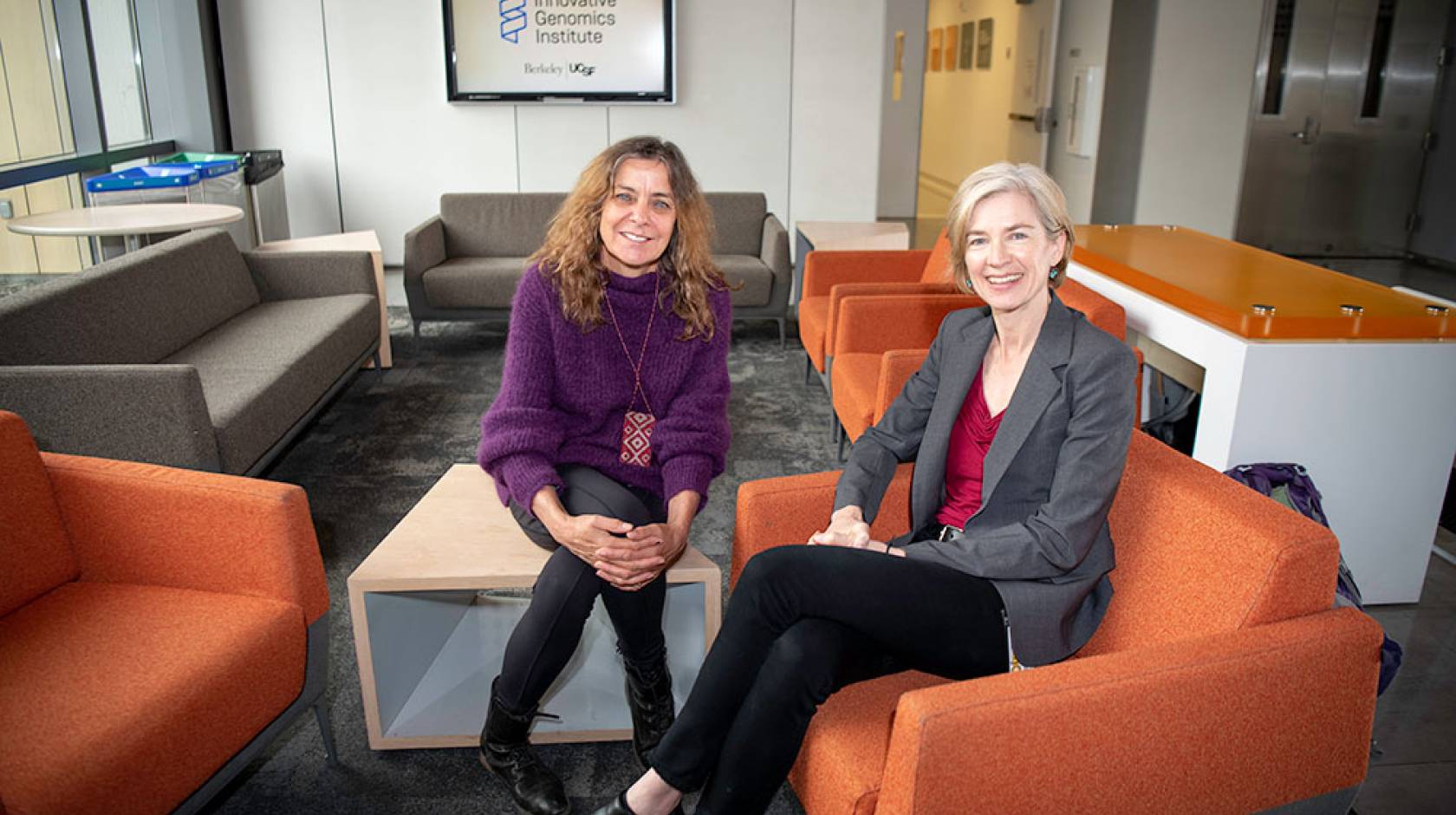Andy Murdock, UC Berkeley

The Audacious Project, an initiative housed at TED, encourages the world’s greatest changemakers to dream bigger. A new initiative led by Jennifer Doudna and Jill Banfield at the Innovative Genomics Institute and announced today at the TED Conference in Vancouver is a big dream that uses the smallest tools: microbes.
The research initiative, “Engineering the Microbiome with CRISPR to Improve our Climate and Health,” will receive $70 million in funding from donors, making it the largest scientific project funded through The Audacious Project to date. It involves a close collaboration across three University of California campuses — the Innovative Genomics Institute (IGI) at UC Berkeley, UC Davis, and UC San Francisco — that capitalizes on the strengths of each institution.
“This cutting-edge initiative will harness the University of California’s research prowess to solve real-world problems in areas that affect us all: sustainability and health,” says University of California President Michael V. Drake, MD. “I’m very pleased to see multiple UC entities working collaboratively to develop and deploy new technology for the public good. I’m grateful to our philanthropic partners for supporting impactful research that will change the world for the better.”
The two project leaders have a unique connection: Doudna is best known for her groundbreaking work developing CRISPR genome editing, for which she received the Nobel Prize in Chemistry in 2020; Banfield studied microbial communities for decades and first introduced Doudna to CRISPR systems in bacteria, at a fortuitous meeting at a UC Berkeley café in 2006. Now, they’re bringing their specialties together to develop a new toolkit to address global problems in climate and human health by applying CRISPR genome editing to complex microbial communities known as “microbiomes.”
“This is an exciting new frontier for CRISPR,” says Doudna. “The precision tools we’re developing will help us understand how microbiomes work at the fundamental level. And we can leverage that knowledge to address problems caused by microbes.”
The Supersized Impact of Miniature Microbes
Though invisible to the naked eye, microbes — bacteria, fungi, viruses, and other microscopic organisms — are everywhere. They account for the vast majority of life’s diversity and they shape the world in significant but often overlooked ways. While scientists have historically studied microbes individually, they commonly live in complex communities, or microbiomes, in the environment around us, and on and even in our bodies. In fact, there are more microbial cells in our body than human cells, and we depend on them for a variety of functions — but when out of balance, microbiomes can also create problems instead.
There is a growing understanding in the medical community that microbiomes in our gut, our airways, and on our skin can significantly impact health issues, including asthma, allergies, obesity, cardiovascular disease, and neurological disorders like Alzheimer’s disease. These health issues affect hundreds of millions of people around the world, and in many cases disproportionately affect people of color and low-income communities.
Microbiomes also represent a significant and largely unaddressed source of global greenhouse gas emissions. Microbes from livestock, agricultural soils, and landfills emit methane and nitrous oxide. Cow burps are commonly pointed to as a major source of methane, but those burps actually originate from methane-producing microbes in the animals’ guts.
Currently, the tools we have to address problem-causing microbiomes are blunt. Antibiotics wipe out whole populations of beneficial and harmful bacteria, probiotics have limited impact, and fecal transplants have shown some promise in specific areas, but face concerns with safety and acceptance.
The IGI team is developing a revolutionary new approach to precisely control microbiomes by building on two state-of-the-art methods pioneered by Doudna and Banfield that have both developed significantly over the past decade: CRISPR genome editing and genome-resolved metagenomics. Less than 1 percent of microbial species can be cultured in the lab, but genome-resolved metagenomics removes the need to grow individual species one-by-one by providing a detailed map of all organisms in a microbiome and the functions of their genes. Banfield and collaborators used these techniques in a 2016 paper in Nature Microbiology to develop a new, clearer picture of the tree of life, showing just how much of the tree is dominated by unseen microbes.
Pairing genome-resolved metagenomics with CRISPR genome editing provides the opportunity and the necessary knowledge to fine-tune microbiomes by making highly targeted changes to specific genes in specific microbes.
“DNA is the instruction manual for an organism and CRISPR is a tool that can rewrite the manuals to fundamentally change how organisms work,” says Banfield. “Genome-resolved metagenomics is the way we can read the instruction manual for any organism and it has brought to light tens of thousands of organisms that we didn’t even know existed.”
In a 2022 paper in Nature Microbiology, Doudna, Banfield, and their teams showed for the first time that they could precisely edit genes directly within complex microbiomes, including model systems that replicated natural soil and infant gut microbiomes. The new initiative builds on that work, and is focused on refining the toolkit into a precision microbiome editing platform, as well as creating a new class of interventions to treat and prevent human diseases, and reduce greenhouse gas emissions to help reach global climate goals.
| Read more: Precision Microbiome Editing 101 |
Tiny Greenhouse Gas Emitters, Big Impact
Methane is one of the most problematic greenhouse gasses arising from human activity, dramatically more potent at warming the atmosphere than carbon dioxide, and responsible for 30 percent of global temperature rise since the Industrial Revolution. Much like the cow burp problem, methane emissions from landfills, waste lagoons, and rice paddies also originate from methane-producing microbes. Over half of human-driven methane emissions are microbial in origin, and they share another key trait: we don’t currently have the tools to deal with them at a global scale.
Livestock alone accounts for nearly 15 percent of all human-driven greenhouse gas emissions, making animal agriculture a key piece of the climate change puzzle. Matthias Hess and Ermias Kebreab at UC Davis, who are co-PIs heading the livestock methane emissions portion of the new initiative, are leading researchers into dietary interventions to reduce greenhouse gas emissions from livestock. One particular intervention is effective in cows: red seaweed. Feeding cows a specific type of red seaweed decreases the expression of methane-producing genes in specific microbes in the cow’s gut, resulting in a dramatic drop in methane emissions. Providing enough seaweed for daily consumption by the global cow population is a daunting task and would most likely not work for grazing cattle that make up the majority of livestock around the globe. An early intervention with CRISPR, however, could result in a permanently low-methane cow and provide a treatment accessible to nearly every calf.
“The vision is to get to a point where an oral treatment delivered to a young calf could provide a lifetime of low emissions,” says IGI Executive Director Brad Ringeisen. “To meet the scale of global agriculture, a solution needs to be simple and affordable for it to create the impact we need.”
| Read more from UC Davis: Can CRISPR Cut Methane Emissions from Cow Guts? |
Preventing Childhood Asthma
Asthma affects 300 million children globally. We can treat asthma symptoms, but currently we have no treatments that can prevent or cure it. We do, however, know a promising new target thanks to research from Sue Lynch, co-PI on asthma applications for the new initiative and Director of the Benioff Center for Microbiome Medicine at UCSF.
Lynch and her collaborators found that different microbiome compositions in infant guts increase the risk of developing asthma. Follow-up research identified a specific inflammatory compound produced by gut bacteria in children who develop asthma and also pinpointed which bacteria produce the greatest concentration of that metabolite, promising targets for an intervention.

“What makes this collaboration so special is that beyond the promise of microbiome-based genome-resolved metagenomics and CRISPR-Cas technology, we have the infrastructure within the Benioff Center for Microbiome Medicine and the clinical capacity at UCSF to translate these approaches into human therapeutics,” says Lynch.
In the US, developing this therapy would have the greatest impact on people of color, who disproportionately shoulder the burden of asthma. Globally, it would have an outsized impact on people in low- and middle-income countries, where the majority of asthma-related deaths occur.
“Developing CRISPR-based medicines to treat allergies and asthma is just the beginning — it’s a proof of concept. There are many other conditions we can ultimately target using this approach,” says Lynch.
| Read more from UCSF: CRISPRing the Microbiome to Prevent Childhood Asthma |
From Petri Dishes to the World
This is not the first time the IGI has taken on a project that involves translating a lab discovery into a real-world tool. A CRISPR-based therapy for sickle cell disease developed at the IGI is currently in a phase I clinical trial. Agricultural products, including a drought-tolerant variety of rice, are undergoing field trials.
“Our initiative is ‘Audacious.’ It’s new, big, and bold,” says Doudna. “We’re driven by the potential for impact: a single novel technology could create new interventions for both human health and combating climate change. That potential is what keeps me excited about science.”
Banfield shares Doudna’s vision for the potential for new discoveries, even as the team initially focuses on specific applications.
“The microbial world is vast and still relatively unexplored,” says Banfield. “These tools will help us understand the genetic landscape of crucial microbes, as well as identify targets for future interventions.”
To maximize the impact around the world, the IGI team has pledged to disseminate their learnings and tools to the wider research community, and work with global nonprofits to help scale this transformative approach.

